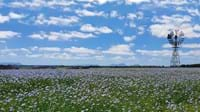Waltanna Farms - Blog #9
Flax Vs Chia
Date: 23/10/2025
When you’re looking to add more fibre, protein, and omega-3s to your diet, two names always pop up — flaxseed and chia seed. They’re often compared side-by-side, and for good reason: they share similar nutrition, versatility, and health benefits.
So why should you choose flaxseed over chia? There’s one important question to start with:
Is it grown locally?
Chia (Salvia hispanica) is native to South America, where it has been grown for centuries. Although in recent years, limited chia production has begun in Northern Queensland, Chia locally sourced has not always been an option.
Flaxseed (Linum usitatissimum), by contrast, has deep roots in Australian agriculture — particularly in southern regions such as Victoria, South Australia, and Tasmania. Many Australian farms have cultivated flaxseed for generations, ensuring traceability and lower transport miles.
If supporting local producers and reducing food miles matter to you, flaxseed comes out ahead.
Important nutritional considerations for the seed
|
Nutrient (g/100g) |
Flaxseed |
Chia Seeds |
|
Energy (kJ) |
1900 |
1559 |
|
Protein (g) |
19.8 |
23.8 |
|
Dietary Fibre (g) |
32.4 |
33.4 |
|
Total Fat (g) |
33.5 |
29.8 |
|
Omega 3 (g) |
19.1 |
18.8 |
|
ALA (g) |
56.4 |
59.8 |
|
Contains all essential amino acids |
√ |
√ |
At a glance, flaxseed and chia seed are remarkably similar — both rich in plant protein, dietary fibre, and alpha-linolenic acid (ALA), a type of omega-3 fatty acid important for heart and brain health.
Culinary and Functional Similarities
- Both become gel-like when soaked, making them ideal for vegan puddings, smoothie thickeners, and egg replacers in baking.
- Both are neutral-tasting, blending easily into cereals, yoghurt, or baked goods.
- Both contribute to gut health and satiety thanks to soluble and insoluble fibre.
Subtle but Meaningful Differences
|
Aspect |
Flaxseed |
Chia Seed |
|
Plant family |
Linum usitatissimum |
Salvia hispanica |
|
Growing region in Australia |
South & temperate zones |
Northern Queensland / NT |
|
Cost & availability |
More affordable, widely available |
Often higher priced |
|
Phytonutrient focus |
Lignans (antioxidant phytoestrogens) |
Polyphenols (chlorogenic acid etc.) |
|
Taste & texture |
Mild, slightly nutty |
Milder, crunchier |
While both offer impressive nutrient density, flaxseed’s unique lignans provide an extra antioxidant boost — and being Australian-grown makes it a sustainable and budget-friendly choice.
The Real Takeaway
Why choose one when you can enjoy both?
The best diet is one built on diversity, featuring a mix of whole seeds — flax, chia, sunflower, and pumpkin — to deliver a wider spectrum of nutrients and plant compounds.
If you’re shopping with sustainability and local support in mind, flaxseed is your everyday hero: nutrient-dense, versatile, and grown right here in Australia.
Try Australian-Grown Flaxseed
Waltanna Farms’ flaxseed and golden flaxseed are proudly grown, cleaned, and packed in Victoria.
Add a spoonful to your breakfast, baking, or smoothies and enjoy a simple way to boost your omega-3s — naturally.



